Even if you’ve never made homemade bread or worked with yeast before, this homemade crusty artisan bread is for you. It’s the perfect beginner recipe because it only requires 4 ingredients without any special pans or mixer, there’s no kneading or complicated shaping involved, and 95% of the work is hands-off. Bread masters will appreciate this recipe too because it delivers with delicious flavor, a slightly crisp and mega chewy crust, and those signature soft holes inside like ciabatta or French bread.
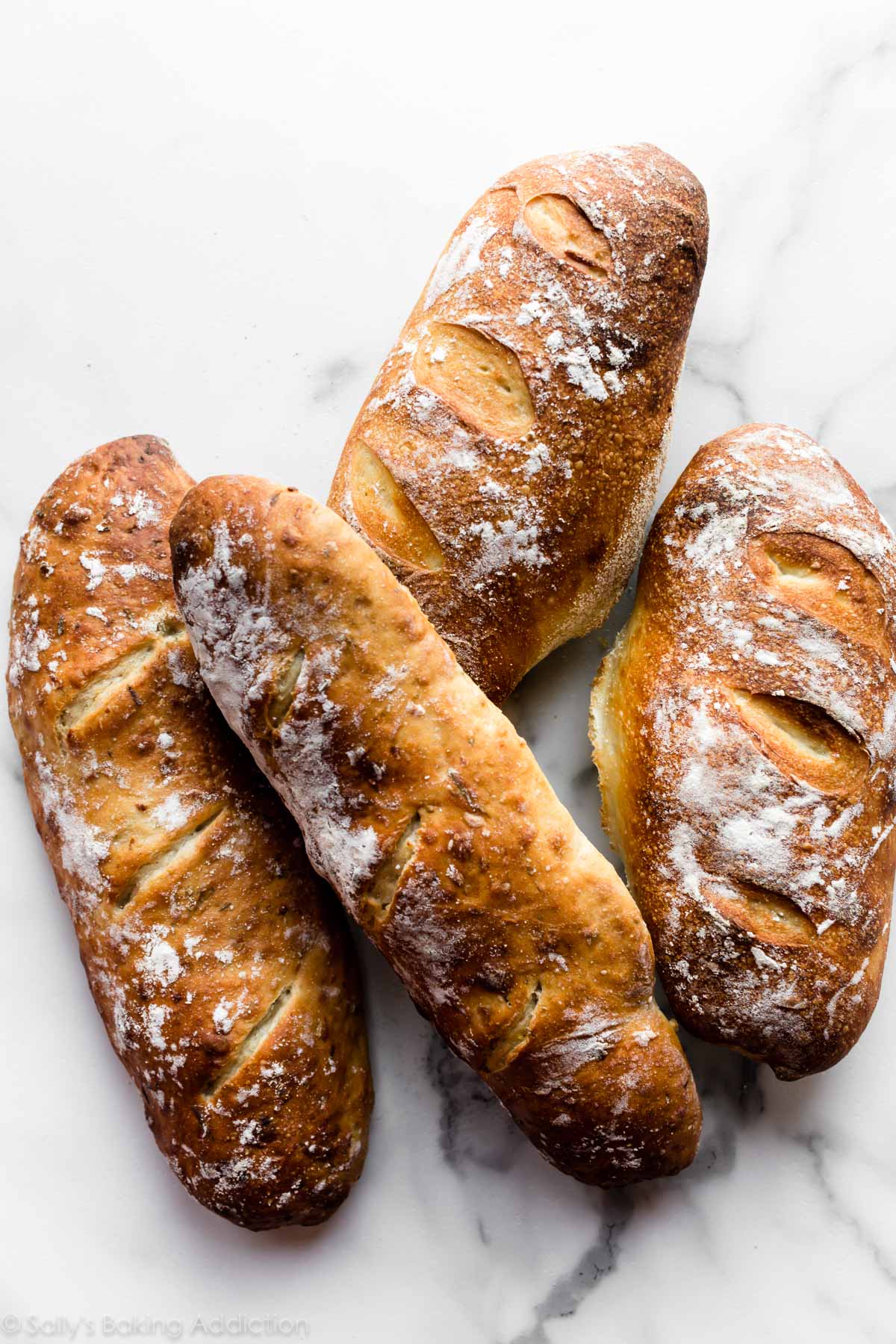
Bread Beginners—Start Here
Have you ever wanted to master homemade bread? Real, crusty, chewy, delicious bakery-style loaves that taste incredible with dips, soups, sauces, and comforting dinners? This is where you start. This artisan bread recipe is for beginners, but even bread masters will appreciate its flavor and ease. It’s so fresh, so flavorful, and so surprisingly easy because it basically makes itself.
You only need 4 ingredients without any special pans or mixer, there’s no kneading, no poolish or dough starter required, and you can add herbs, cheeses, and spices to make a variety of bread flavors.
This base recipe will soon be on repeat in your kitchen. After you realize how easy it is to make real homemade bread, you’ll find any excuse to bake a loaf. You can even turn it into garlic bread and homemade croutons.

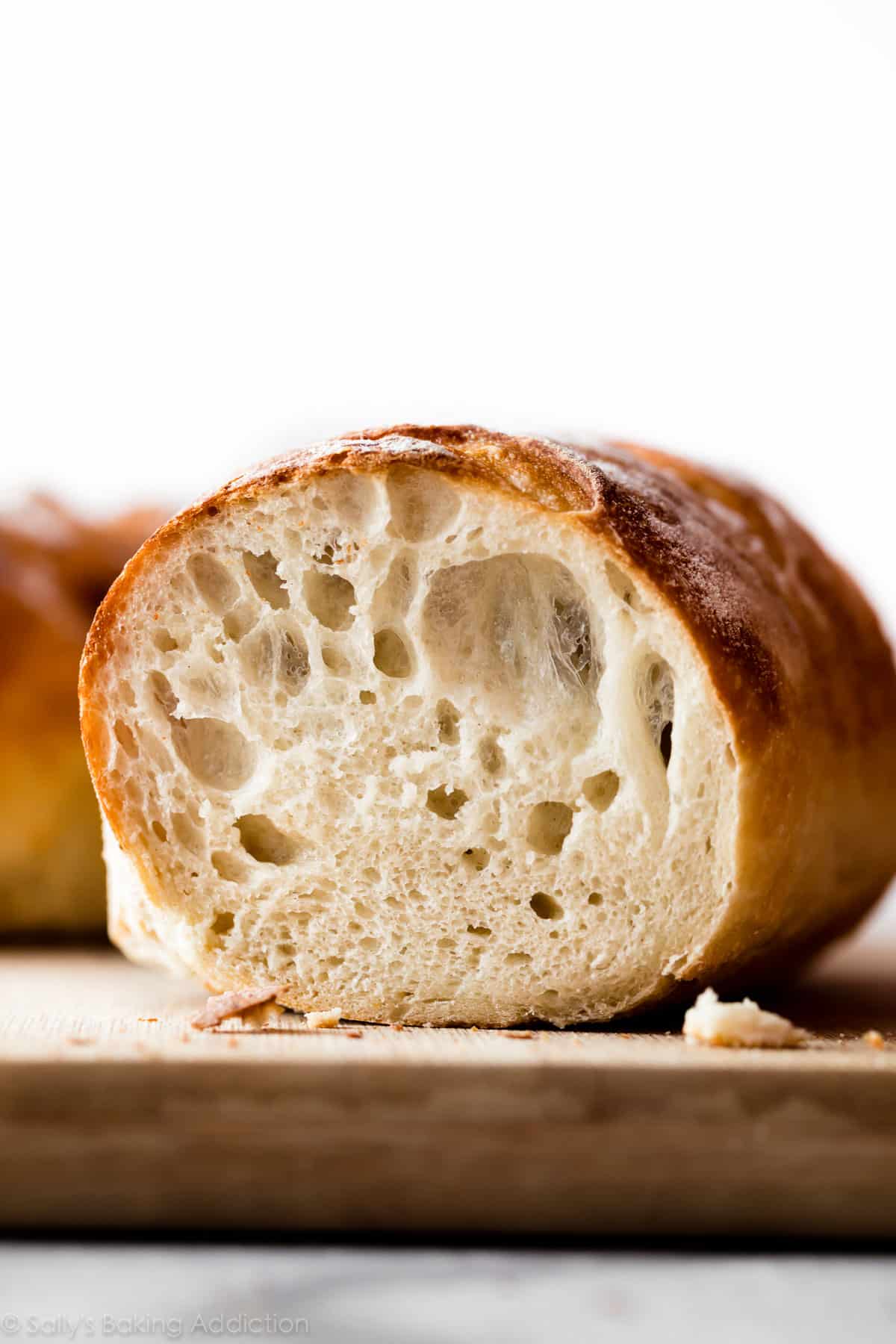
What is Homemade Artisan Bread?
When it comes to bread, the term “artisan” doesn’t mean 1 particular thing. But, generally, artisan bread is homemade, fresh, crusty, and deliciously rustic-looking. An artisan is a skilled worker, one who works with their hands. But ironically, there isn’t much “work” involved with this recipe.
Why You’ll Love This Bread Recipe
- Easier than you ever imagined
- Soft + flavorful
- Chewy, slightly crisp crust
- Shape however you want
- No special pans, poolish, or dough starter required
- Only 4 ingredients
- You decide the length of time it rests
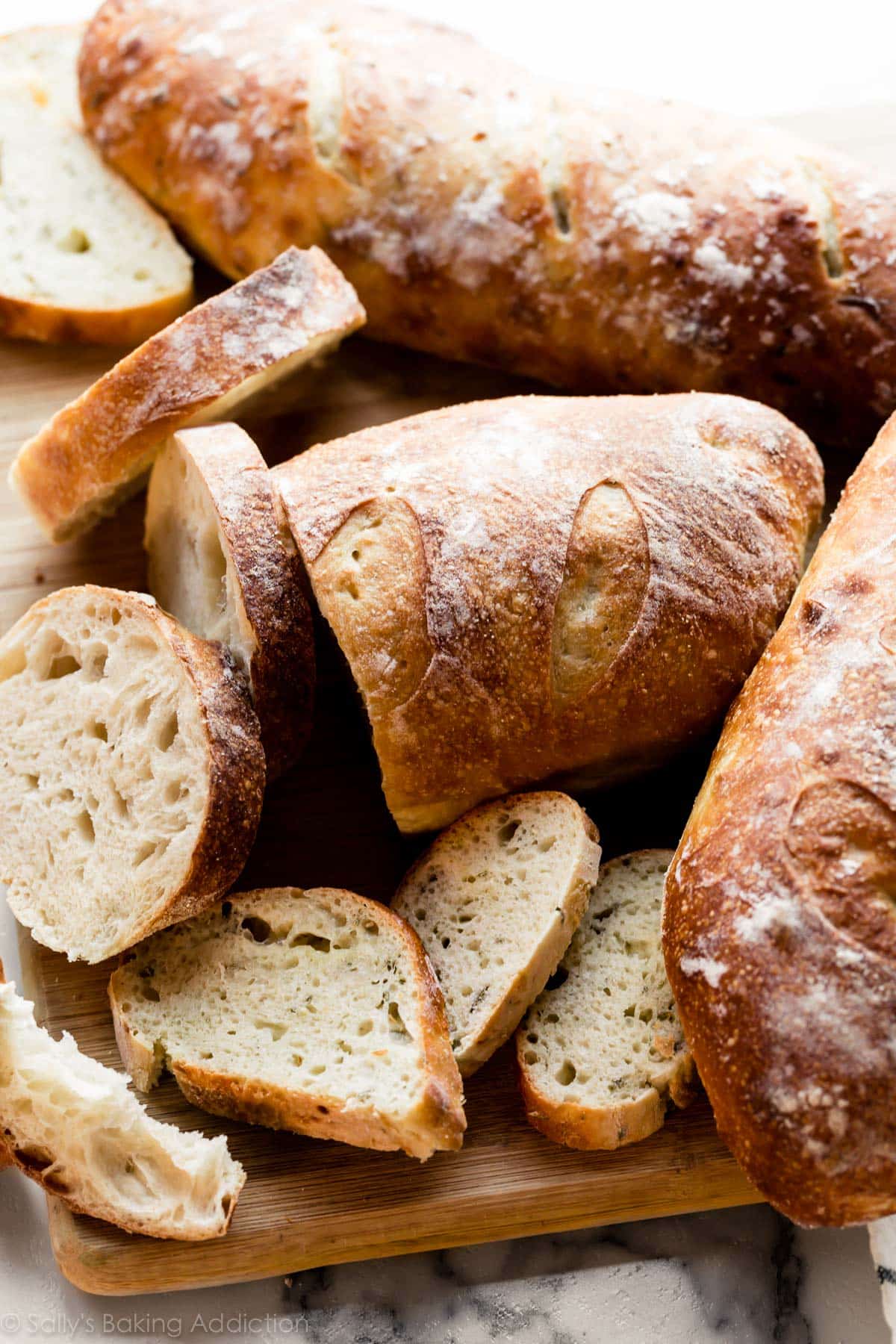
Like sandwich bread, whole wheat bread, focaccia, homemade English muffins, seeded oat bread, and homemade bagels—the process is surprisingly easy. If you’re new to yeast, reference my Baking with Yeast Guide for answers to common yeast FAQs.
Only 4 Ingredients
The crustier and chewier the bread, the less fat in the dough—also known as a “lean dough.” We’re using a lean dough for our artisan loaf today. (If you’re curious, a “rich dough” is a soft bread dough with the presence of fat, such as butter and eggs—the kind we need for overnight cinnamon rolls, sweet potato dinner rolls, brioche, and honey butter rolls.) Without fat, we’re left with the basics.
- Bread Flour: While you can use all-purpose flour in this recipe, I strongly recommend using bread flour. Just like when we make olive bread, pizza bread, and asiago-crusted skillet bread, bread flour produces a stronger, chewier bread and that makes a big difference in a recipe with only 3 other ingredients.
- Instant Yeast: Instant yeast is key in this recipe. While you can use active dry if that’s all you have, any quick rise or instant yeast will produce flavorful results in less time. I use more yeast in this recipe compared to my cranberry nut no-knead bread and no-knead jalapeño cheddar bread. Why? Those doughs rest and rise at room temperature. However, for more flavor and just as much rise, I use more yeast and let this dough rest in the refrigerator. (Cool air slows the fermentation process.)
- Salt: You can’t make good bread without salt and for best flavor, I recommend a coarse salt, such as coarse sea salt. I find the bread’s flavor lacking with regular table salt.
- Water: I normally encourage you to use warm liquid with yeast because warm liquid helps the yeast work faster. However, use cool or room temperature water here. Not freezing cold, not super warm—cool to touch. 70°F (21°C) is great, but the exact temperature doesn’t matter as long as it’s not hot or warm. The cooler the water, the longer the dough takes to rise and, usually, the better the bread’s flavor. (This is important since there are so little ingredients to add substantial flavor!) We use the same cool water method for no knead honey oat bread.
- Optional Cornmeal: Dusting the pan with cornmeal adds a pop of flavor and a little crunch to the bottom crust. This is completely optional. If you have it, use it. If you don’t have it, don’t worry about it.
You can also add herbs and seasonings such as garlic, rosemary, dill, chopped onion, jalapeño, shredded cheese, chopped nuts, dried cranberries, etc. My no yeast bread is the quick bread alternative here—you can add flavors to that loaf, too!
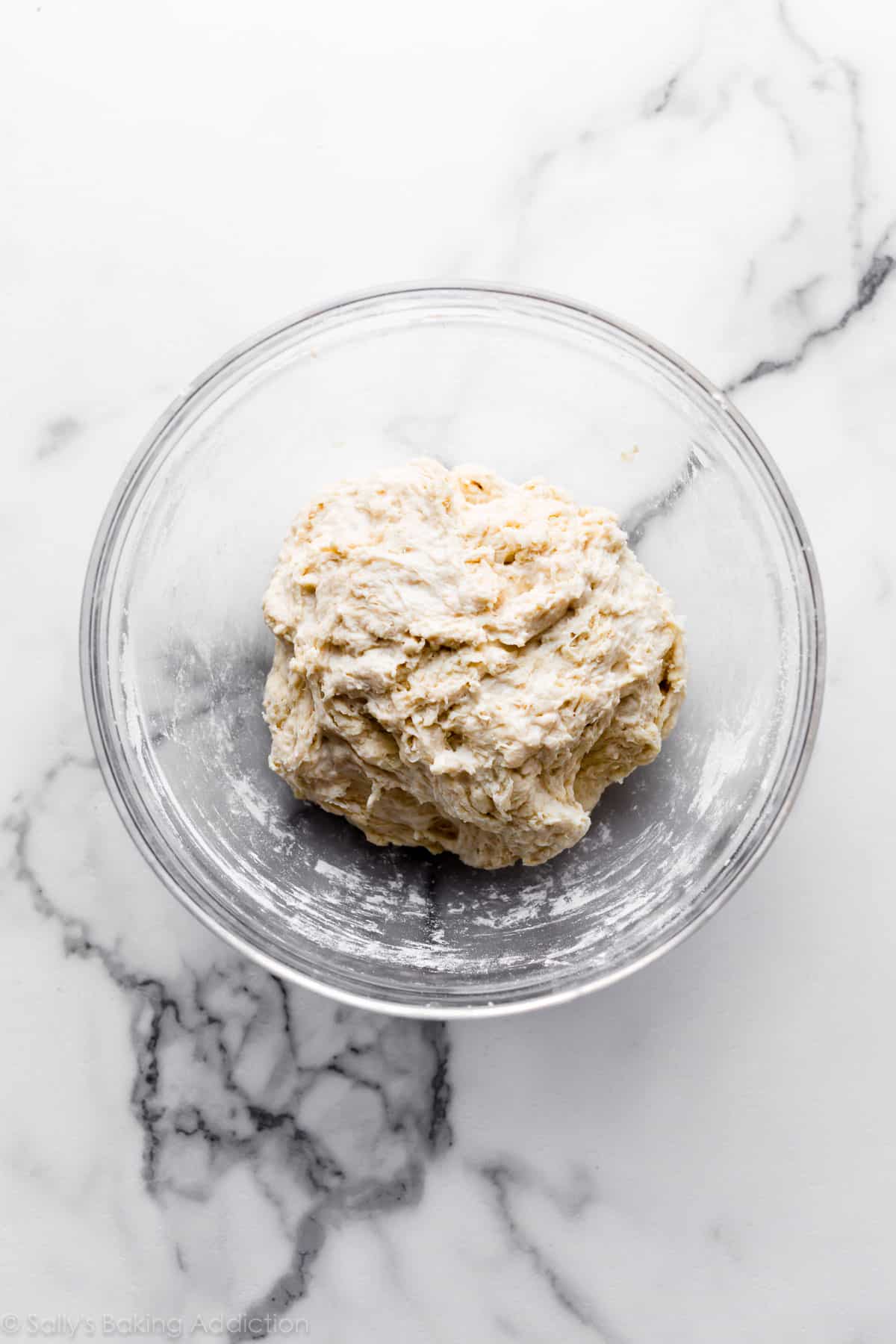
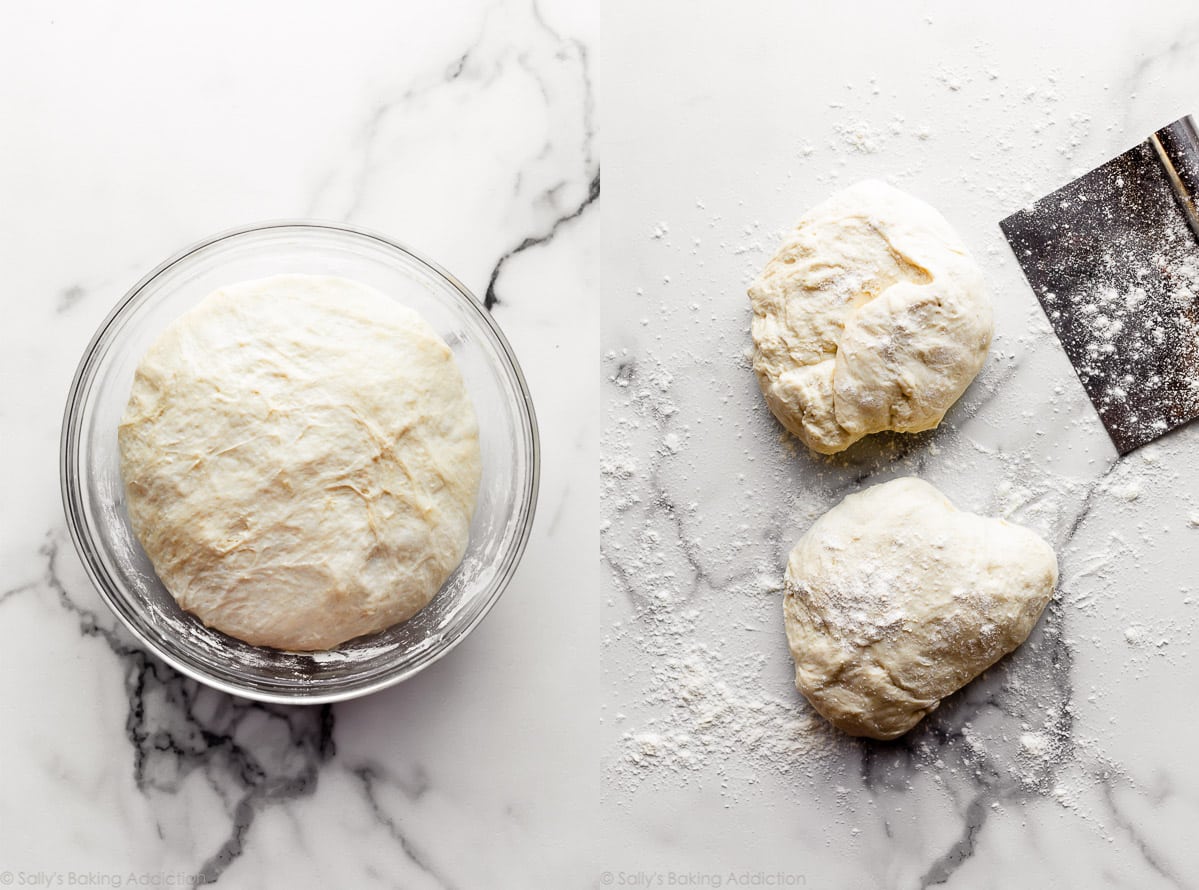
Baker’s Tip: Avoid adding too much flour to the dough as you work with it. The stickier it is—and the longer it sits in the refrigerator—the more likely you’ll have those big airy pockets of air in the crumb.
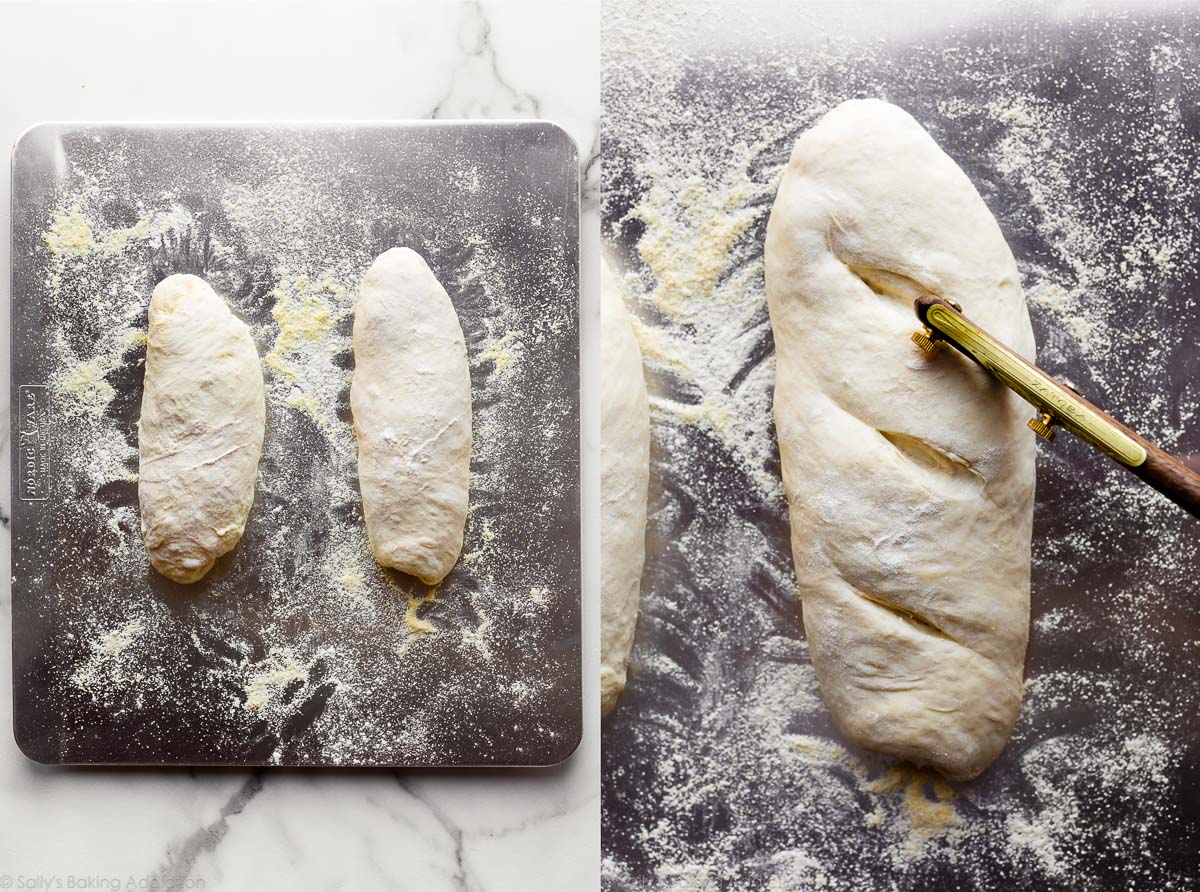
How to Make Homemade Artisan Bread in 5 Steps
- Mix the dough ingredients together. At first the dough will seem very dry and shaggy and you’ll question if it will even come together. But it will. Use a spatula at first, then switch to your hands to ensure all of the flour is moistened. The dough is actually a little sticky after it’s thoroughly mixed.
- Let it rise at room temperature for 2-3 hours. Cover the dough and let it rise at room temperature for about 2-3 hours until doubled in size.
- Use right away or refrigerate. After 2-3 hours, you can immediately continue with the next step. However, for ideal flavor and texture, I strongly recommend letting the dough sit in the refrigerator for at least 12 hours and up to 3 days. Yes, 3 full days! I usually only let it rest for about 18 hours. During this crucial step, the cold air slows the fermentation process and adds so much flavor and texture. So, you can bake bread in 2-3 hours or in 3 days. The longer it sits, the better it tastes. 🙂
- Shape into 2 loaves or 1 boule. Rest as oven preheats. You can shape the bread into a round loaf (boule) or two longer loaves. I usually make two longer loaves side-by-side on a flat baking sheet, about 9×3 inches each. Preheat the oven to a very hot 475°F (246°C). The extremely hot air will immediately set the crust so the bread rises up instead of spreading all over. Score the loaves on top right before baking. Scoring also helps control the bread’s expansion. To help ensure a crispier crust, after the oven preheats, pour boiling water into a metal or cast iron baking pan on the bottom oven rack. Immediately place the baking sheet inside and shut the oven door to trap the steam. The steam will help create that coveted crisp crust.
- Bake until golden brown, about 20-25 minutes. Gently tap the loaves because if they sound hollow, they’re done.
Look at those deliciously soft holes inside! Reminds me of ciabatta or a French baguette, both of which can be a little more complicated to make.
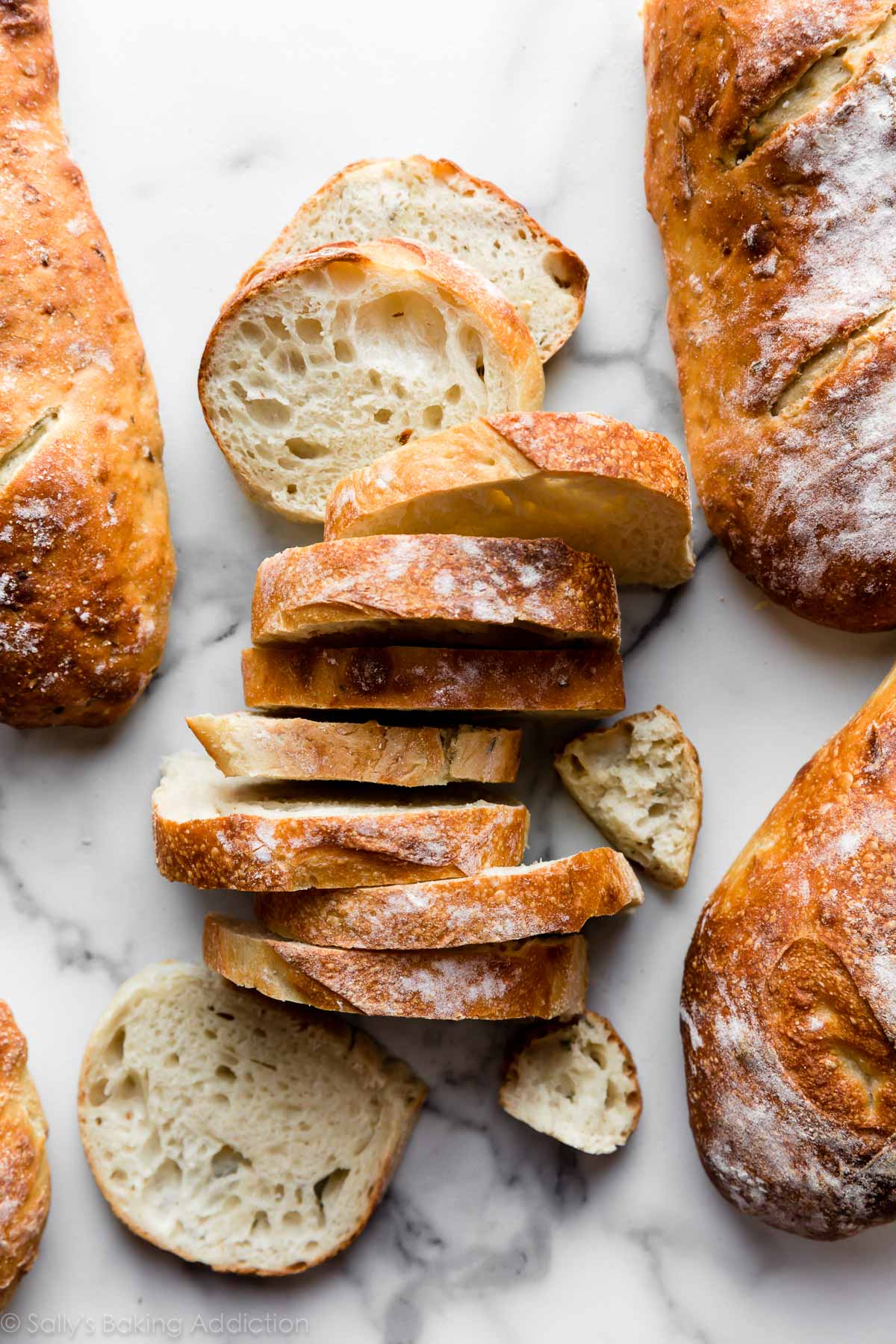
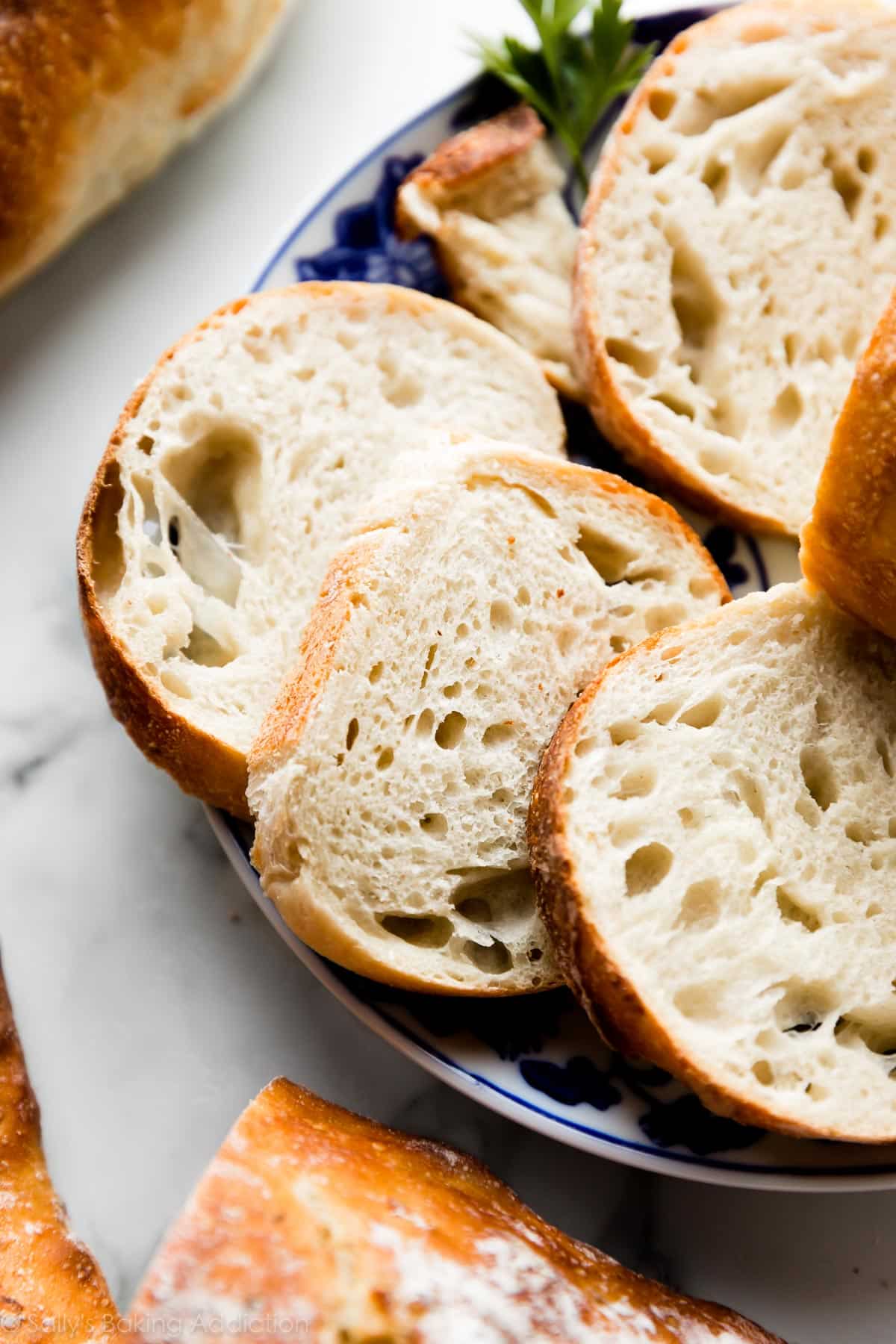
Serve Artisan Bread With
- Slather with homemade honey butter or cinnamon butter
- Slice and dunk in crab dip, beer cheese dip, garlic & bacon spinach dip, or even homemade Italian dressing
- Serve alongside slow cooker chicken chili or pumpkin chili
- As a dunker for creamy cauliflower potato soup, minestrone soup, creamy chicken noodle soup, or crab soup
- With a big bowl of mac & cheese or spaghetti with slow cooker turkey meatballs
- Use for my goat cheese & honey crostini
- It’s the perfect starch in breakfast casserole or baked apple cider French toast
- Use it to make homemade garlic bread or homemade croutons
- With anything because homemade bread is everything’s best friend
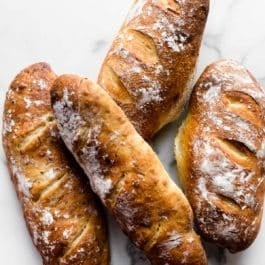
Homemade Artisan Bread Recipe
- Prep Time: 4 hours
- Cook Time: 25 minutes
- Total Time: 4 hours, 25 minutes
- Yield: 2 8-inch loaves
- Category: Bread
- Method: Baking
- Cuisine: American
Description
Even if you’ve never made homemade bread or worked with yeast before, this homemade artisan bread is for you. Watch the video tutorial below and review the recipe instructions and recipe notes prior to beginning. If you’re new to working with yeast, reference my Baking with Yeast Guide for answers to common yeast FAQs.
Ingredients
- 3 and 1/4 cups (about 430g) bread flour (spooned & leveled), plus more for hands and pan
- 2 teaspoons (about 6g) instant yeast
- 2 teaspoons (about 9g) coarse salt (see note)
- 1 and 1/2 cups (360ml) water, close to room temperature at about 70°F (21°C)
- optional: cornmeal for dusting pan
Instructions
- In a large ungreased mixing bowl, whisk the flour, yeast, and salt together. Pour in the water and gently mix together with a silicone spatula or wooden spoon. The dough will seem dry and shaggy, but keep working it until all the flour is moistened. If needed, use your hands (as I do in the video tutorial below) to work the dough ingredients together. The dough will be sticky. Shape into a ball in the bowl as best you can.
- Keeping the dough in the bowl, cover the dough tightly with plastic wrap or aluminum foil and set on the counter at room temperature (honestly any normal room temperature is fine!). Allow to rise for 2-3 hours. The dough will just about double in size, stick to the sides of the bowl, and have a lot of air bubbles.
- You can continue with step 4 immediately, but for absolute best flavor and texture, I strongly recommend letting this risen dough rest in the refrigerator for at least 12 hours and up to 3 days. Place covered dough in the refrigerator for 12 hours – 3 days. I usually let it rest in the refrigerator for about 18 hours. The dough will puff up during this time, but may begin to deflate after 2 days. That’s fine and normal—nothing to worry about.
- Lightly dust a large nonstick baking sheet (with or without rims and make sure it’s nonstick) with flour and/or cornmeal. Turn the cold dough out onto a floured work surface. Using a sharp knife or bench scraper, cut dough in half. Some air bubbles will deflate as you work with it. Place dough halves on prepared baking sheet. Using floured hands, shape into 2 long loaves about 9×3 inches each (doesn’t have to be exact) about 3 inches apart. Loosely cover and allow to rest for 45 minutes. You will bake the dough on this prepared baking sheet.
- During this 45 minutes, preheat the oven to 475°F (246°C).
- When ready to bake, using a very sharp knife or bread lame (some even use kitchen shears), score the bread loaves with 3 slashes, about 1/2 inch deep. (“Score” = shallow cut.) If the shaped loaves flattened out during the 45 minutes, use floured hands to narrow them out along the sides again.
- Optional for a slightly crispier crust: After the oven is preheated and bread is scored, place a shallow metal or cast iron baking pan or skillet (I usually use a metal 9×13-inch baking pan) on the bottom oven rack. Carefully and quickly pour 3-4 cups of boiling water into it. Place the scored dough/baking pan on a higher rack and quickly shut the oven, trapping the steam inside. The steam helps create a crispier crust.
- Place the shaped and scored dough (on the flour/cornmeal dusted pan) in the preheated oven on the center rack. Bake for 20-25 minutes or until the crust is golden brown. Gently tap the loaves—if they sound hollow, the bread is done. For a more accurate test of doneness, the bread is done when an instant read thermometer inserted in the center reads 195°F (90°C).
- Remove the bread from the oven and allow to cool for at least 20 minutes before slicing and serving. Store leftovers loosely covered at room temperature for up to 5 days or in the refrigerator for up to 1 week.
Notes
- Make Ahead & Freezing Instructions: The dough can sit in the refrigerator for up to 3 days, so this is a wonderful recipe to begin ahead of time. You can also bake the bread, allow it to cool, and freeze for up to 3 months. Thaw at room temperature before serving. You can also freeze the dough. Complete the recipe through step 3. Wrap in plastic wrap and place in a freezer-friendly container. To bake, allow dough to thaw overnight in the refrigerator, or for 2-3 hours at room temperature. Continue with step 4 and the rest of the recipe instructions.
- Special Tools (affiliate links): Glass Mixing Bowls | Silicone Spatula or Wooden Spoon | Baking Sheets | 2-cup Measuring Cup | Bread Lame | Instant Read Thermometer
- Flour: For absolute best flavor and chewy texture, I strongly recommend using bread flour. You can use a 1:1 substitution of all-purpose flour in a pinch with no other changes to the recipe. I recommend avoiding whole wheat flour in this dough. If necessary, use half bread flour and half whole wheat flour. The bread will taste dense.
- Yeast: You can use instant or active dry yeast, but I highly recommend an instant (aka “rapid rise” or “quick rise” yeast). The bread will rise faster. I usually use Platinum yeast by Red Star, which is an instant yeast. 2 teaspoons is a little less than 1 standard packet. If using active dry yeast, there are no changes needed to the recipe. The rise time in step 2 may take longer.
- Salt: Use a coarse salt, such as coarse sea salt, in this bread. I find the flavor slightly lacking when using regular table fine salt. If you only have fine salt, reduce to 1 and 1/2 teaspoons.
- Water: Use cool water. 70°F (21°C) is great, but the exact temperature doesn’t matter as long as it’s not hot or warm.
- Round Loaf: If you want to shape the dough into a boule (round loaf) simply shape into a round ball instead of 2 loaves in step 4. Baking instructions are the same, but the loaf will take a few extra minutes in the oven. If you want to bake the boule in a dutch oven, see next note.
- Using a Dutch Oven: Follow this dough recipe through step 3, then follow the simple shaping/baking instructions (steps 2-5) in my Cranberry Nut No Knead Bread recipe including using the parchment paper. If your parchment paper can’t withstand heat this high, you can either lower the oven temperature and bake the bread for longer or grease the Dutch oven instead.
- Using a pizza stone: If you want to bake your bread loaves on a pizza stone, place pizza stone in the preheating oven. In step 8, place the shaped and scored dough on your preheated pizza stone. If the bottom of the shaped dough is pretty sticky, dust the hot pizza stone with some extra cornmeal. Bake as directed.
- No Nonstick Pan: If you don’t have a nonstick baking sheet, line it with parchment paper instead. Coat with a dusting of flour and/or cornmeal before placing the dough on top. Parchment paper can burn, so it’s best to check the box to see how much heat yours can tolerate. Lower your oven heat if necessary and bake the bread for longer until golden brown and when gently tapped, sound hollow.
- Flavor ideas: Before pouring in the water in step 1, add any of the following ingredients/combination of ingredients to the dry ingredients in the bowl: 4 cloves minced garlic + 3 Tablespoons chopped rosemary, 3 Tablespoons your favorite fresh herb (chopped), 1 cup your favorite shredded cheese, a diced jalapeño, 3/4 – 1 cup dried cranberries and/or chopped nuts, 2 teaspoons garlic powder, etc.
- Reference my Baking with Yeast Guide for answers to common yeast FAQs.
- Recipe adapted from King Arthur Flour & Red Star Yeast, similar method originally from Jim Lahey.
Nutrition
- Serving Size: 2 slices
- Calories: 136
- Sugar: 0.1 g
- Sodium: 389.8 mg
- Fat: 0.7 g
- Carbohydrates: 27.2 g
- Protein: 4.7 g
- Cholesterol: 0 mg

















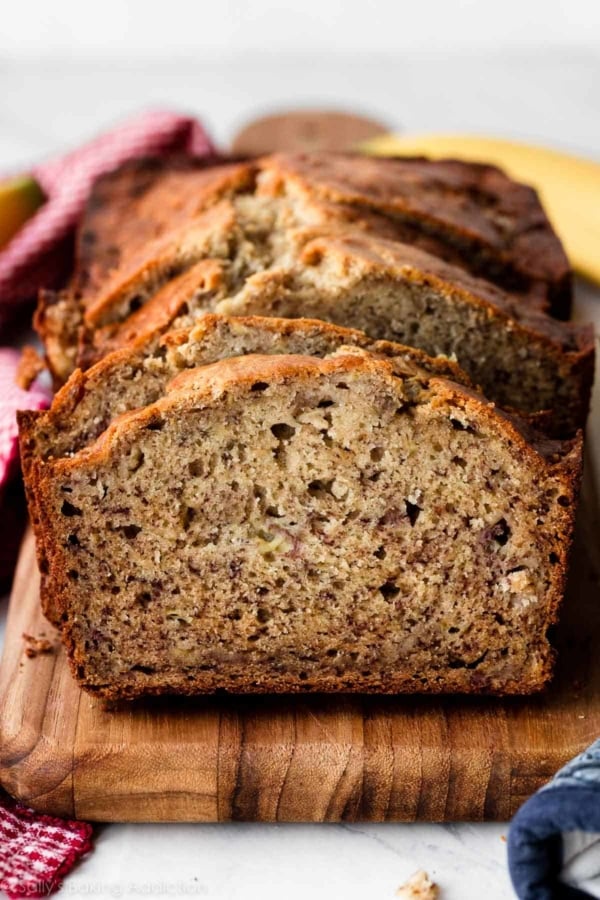

Reader Comments and Reviews
I thought this was for rolls like in the picture. Can it be?
Hi Laurie, we’re unsure what you mean – this recipe makes 2 8-inch loaves.
Hi,
Thanks for this recipe. I have made it several times, and the taste and smell is amazing. However, it comes out a bit doughy. I make it step by step as the recipe says. I am wondering what I could do to make this less doughy?
Thanks,
Aida
Hi Aida, could the bread be under-baked? Do you have an instant read thermometer? The bread is done when an instant read thermometer inserted in the center reads 195°F (90°C).
These came out nice and airy but I had a lot of flour stuck to the bottom maybe I floured the sheet too much? They also weren’t crusty once they cooled. Could I use parchment paper instead of it is rated high temp?
Hi Sarah, yes! You can absolutely use parchment paper here if you prefer.
I recently asked a question about modifying this recipe to add rosemary and olive oil and you referred me to Sally’s Baking 101 for the Rustic Rosemary Garlic Bread. It looks great, but I’m wondering if I could add a tablespoon or two of olive oil. If so, do I need to reduce the water in the recipe by the amount of olive oil I use? It seems like that might add an interesting flavor. Thank you.
Hi Polly, adding more liquid to the dough would take some testing in order to guarantee results, but how about brushing some on top right before baking? The bread would be great dipped in olive oil as well. Let us know what you try!
This bread is so good, I could eat two whole loaves in one sitting. My whole family loves it!
the was so good i could eat two whole loves in one serving
I’m making the Homemade Artisan Bread. Can I use the Dutch oven technique as described in your Cranberry Walnut no knead recipe or do I have to follow the recipe exactly & use a cookie sheet? I don’t have nonstick cookie sheets??? Can I just use corn meal or do I need parchment? Thanks for answering.
Hi Kay, you can absolutely use a Dutch oven—see recipe Notes for details!
I want to make this recipe but use the Boule shape cooked in Dutch oven. This recipe says to follow dough recipe through step 3, which is putting the dough in refrigerator. Then the recipe instructions say I need to go to the cranberry nut no knead bread recipe instructions and follow steps 2 to 5 for the boule. However step 2 says to let the dough rise at room temperature 12-18 hours. I’m not sure if I’m supposed to leave the dough in or out of the refrigerator. Please let me know. Thank you so much.
Hi Deborah, so sorry for the confusion! You can let the artisan bread rest in the refrigerator through step 3, then move right to the shaping directions in step 3 of the cranberry nut bread recipe. No need to let it sit for another 12-18 hours. Hope you enjoy the bread!
This is another great recipe! Thank you! But I am wondering if this recipe could be modified to make sea salt rosemary bread. To do so, could I add 2 tablespoons of olive oil? If so, would I need to reduce the amount of water by 2 tablespoons?
I’m sure you haven’t tried this, but does this make sense if I want to give it a try?
Hi Polly! If you have a copy of Sally’s newest cookbook, Sally’s Baking 101, there’s actually recipe similar to this one called “Rustic Rosemary Garlic Bread”. Let us know what you try!
Thank you! I do have her cookbook and I will try it!
Hi Sally! How would I adjust the recipe if I wanted to make 1 single artisan style bread instead of 2 longer shaped loaves? Would I just bake for longer? Thanks!
Hi Olivia! See recipe Notes for details on baking as one larger boule.
I tried this recipe and it was great. My next step, I hope, is to make wholemeal and multigrain loaves. Can you tell me what I would have to change to do this?………………Thank you…………….Regards…………Del
Hi Del, we recommend avoiding whole wheat flour in this dough. If necessary, use half bread flour and half whole wheat flour. The bread will taste a bit dense. Here is our multigrain bread recipe. Hope you enjoy it!
I’m a pretty avid bread baker. Haven’t bought bread in years, tried this recipe and it was a complete dud. Dough never browned, and was so ungodly dense.
Hi Kim, thanks so much for giving this recipe a try. I’m sorry it didn’t turn out as expected. A pale, dense loaf usually points to an issue with yeast activity or oven temperature/steam. If the dough didn’t rise well before baking, the yeast may have been expired, the water too hot/cool, or the dough may have needed a longer rise/rest time (especially in a cooler kitchen). If you’re up for sharing, I’m happy to help troubleshoot. What kind/brand of yeast did you use, did you use the steam oven trick, and did the dough noticeably expand/rise before baking? We can get to the bottom of it!
Can I use a mixer with a dough hook?
Hi G, We do not recommend a mixer for this particular dough– it’s very loose and sticky. A mixer wouldn’t be doing you (or the dough!) any favors. It’s best to use the mixing bowl & spoon method outlined here.
I never leave reviews ever! This is the best bread I have ever made/tasted. Leave it in the fridge overnight and then bake the next afternoon and it will come out perfect! Thank you, Thank you!!!!!
Can fleischmann’s rapdirise instant yeast be used in the artisan bread recipe?
Hi Tina! Any instant yeast will work here, so that will be fine.
I made this the other night and my whole family raved about it! It didn’t even last 5 minutes. By the way – I accidentally left the dough in the fridge for 6 days but baked it just in case. It didn’t look weird or have a bad smell. Do you know why it lasted that long in the fridge?
I want to know why too! Did it add some extra flavor do you think?
I have made this bread several times now, and it is a big hit with the family. I am going to try with cheese and jalapenos next. I was wondering if I can bake this in a loaf pan?
Hi Jane, there is a little too much dough for a standard size (9×5-inch) loaf pan, so you could try dividing the dough in half and using 2 loaf pans. The edges should still crisp up and the bake time may vary. Let us know how it turns out if you give it a try!
Sally, your vanilla cake recipe has been our family favourite for years. Every birthday cake for 5 of us! I’m excited to try this bread recipe, my efforts are not reliable, so I’m very hopeful your tried and trusted recipe will make the (bread) baker I always wanted to be!
I realized right before bed that I’d wanted to make this tomorrow so I did the first couple steps but put the dough directly into the fridge to rest overnight instead of waiting for it to proof at room temp for 3 hours first. Will it still work? Should I let it sit at room temp in the morning for 3 hours before proceeding? Will update if things work out!
Okay, following up…
I mixed the dough together and immediately put it in the fridge overnight instead of the 3-hour rise.
The next day I followed steps 4 onwards without the 3-hour rise, and everything turned out great!
The dough was super sticky to work with but I found as long as I kept my hands and surfaces very floured, it was fine.
The bread came out perfect, with an airy crumb, crisp crust, and nice salty flavour. Will be making this again, thanks Sally & team!
First time ever making bread, it turned out great! I can’t wait to experiment with different herbs. Very easy to make, just a lot of patience with waiting for the dough.
This was my first attempt at bread. It turned out perfect. I only have a toaster oven, so I baked half today and I’ll bake the rest tomorrow. Thank you!
Hello! I made this at the weekend but I’m not sure I got it right. Is the 246°C the temperature for a regular oven or a fan oven? Thank you!
Hi Hester, the temperature for all of our recipes is for a conventional oven setting – 475°F (246°C) is correct for this recipe. We hope you enjoyed the bread!
Thank you!! I need to bake it at a lower temp next time as I’ve got a fan oven, it was still delicious though! I put a packet of cranberries in and the juices from them gave it a lovely flavour.
This bread recipe is fantastic.l make it 3 days a week
Hi Sally and team
I’m having trouble with my oven it will not reach 250*degrees,
So should I just bake it for longer
as my loaf was still to dense.
Hi Dave, yes, if you have to bake at a lower temperature, you will need to extend the bake time a bit to ensure it is baked through.
I used 1/2 bread flour and 1/2 all purpose (we use what we have lol) and this still turned out amazing! I prefer using a gentle setting on my stand mixer for bread instead of by hand (I can never get the texture right with my hands, idk) and this recipe works perfectly for that too, if anyone is wondering! I probably will try making this into one big loaf/round next time, but I like the 2 smaller loaves in case I wanted to freeze one or gift it!
I know you strongly recommend using bread flour, but all I have is AP and I am on a tight budget! Do you have any tips for improving the bread when using AP flour?
Hi Alex! You can use a 1:1 substitution of all-purpose flour in a pinch with no other changes to the recipe.
Made this today for chili. By far the best no knead bread I’ve ever made. Perfectly chewy, and the crust had a crunch. Will definitely make again.
Are the oven temperatures referred to in the artisan bread for a fan forced oven? My first attempt and want to get it right.:-)
Hi Wayne! We always recommend conventional settings for baking (not convection/fan). The flow of air from convection heat can cause baked goods to rise and bake unevenly and it also pulls moisture out of the oven. If you do use convection/fan settings for baking, lower your temperature by 25 degrees F and keep in mind that things may still take less time to bake.
Second attempt
Yep I did lower the settings by 25o set the time to twenty five min.
Bread not done so I added another 10 min and still not sounding hollow when tapped. Any ideas? Im still going to eat it no matter what)))
Hi Wayne, every oven runs differently and we’ve found that many run a little (or a lot!) off. We’d recommend using an oven thermometer to ensure your oven is baking at the correct temperature. For a more accurate test of doneness, the bread is done when an instant read thermometer inserted in the center reads 195°F (90°C). Hope you enjoyed this bread!!
Delicious! The only thing that was a little confusing is the bottom layer was a little “wet” so I didn’t actually press into the bottom of the pan. I put it in with a spatula and just evened it out. I wasn’t sure if it would be cooked through but they turned out great.
I’ve made this bread a couple of times and it never turns out. After I mix in the water it’s VERY sticky. I let it sit and rise then put it in the refer for about 12-16 hours. When I do turn it out, it’s very sticky and won’t really form into loaves, certainly not like the ones in your video. It spreads out on the pan and no amount of trying to push it back into shape works. It does puff up some in the oven, but it doesn’t get a very good openness once it’s baked. What am I doing wrong please?
Hi CL! It sounds like your dough may be a little too wet. Does yours look like the photos and video tutorial above? You can try adding a little more flour (1 Tbsp to 1/4 cup) until the dough is a little less sticky.
Can you bake in loaf pan?
Hi Nancy, there is a little too much dough for a standard size (9×5-inch) loaf pan, so you could try dividing the dough in half and using 2 loaf pans. The edges should still crisp up and the bake time may vary. Let us know how it turns out if you give it a try!